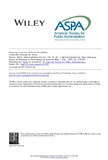| dc.description.abstract | "ONE OF THE CHARACTERISTICS OF BEING
HUMAN," wrote Arnold Toynbee, "is that one
makes plans." One plans what to eat, how to
dress, when to sleep, where to work, and
whether to procreate. One makes such plans
whether woman or man, young or old, poor
or rich, yellow, black, brown, or white.
Another characteristic of being hu-
man is that one becomes part of "we" or
"they." One becomes a member of a family,
an informal group, an association, a formal
organization, or a territorial entity. Each of
these human groups may also make plans-
open or covert, short- or long-range, utopian
or realistic, rigid or flexible, narrow or broad,
detailed or general. In all cases planning tends
to be both "directed by habit, tradition,
previous decision, or external pressure" and
at the same time "spontaneous, inadvertent
and random." 1 Invariably, some people plan
for or against others. Most efforts to imple-
ment plans are impeded not only by scarcities
in resources or planning skills but also by
apathy, competition, or organized resistance.
Hence, to paraphrase the famous lines of
Robert Burns, the best-laid plans of families,
organizations, cities, and nations-as of mice
and men-"aft gang agley." When this hap-
pens-as also with successes-there is both
mourning in some quarters and rejoicing in
others ...
The power of these simple axioms is that
they can be used in looking at villagization
planning in Tanzania; physical, fiscal, social,
and "model cities" planning in New York
City; the planning of military operations by
a general staff; highway subsidy planning by
the automobile-highway-petroleum complex;
sugar production planning by the Castro Gov-
A brief summary of this paper was presented as the
author's presidential address before the Society for
General Systems Research at the 137th Annual Meet-
ing of the American Association for the Advancement
of Science in Chicago on December 27, 1970.
ernment; and the Nixon-Agnew plans for the
1972 election. By themselves, however, they
provide merely a background for trying to un-
derstand the changing styles of planning in
America of the 1970's.
Until recently, after organizing several em-
pirical studies of planning in other countries,2
I looked at planning in the United States in
terms of certain important changes in my own
lifetime (with many of which I had been per-
sonally associated):
1. The steady growth of long-range, cor-
porate planning over the entire period
from the 1920's to the present,
2. The fumbling efforts of the New Deal
to develop a planned escape from the
Great Depression,
3. Large-scale World War II planning of
economic production and military oper-
ations,
4. The sequence of Fair Deal, New Fron-
tier, and Great Society plans for full
employment and social welfare, each
indirectly associated with cold war
"growthmanship,"
5. The developer-speculator planning of
the "march to the suburbs" and of inner-
city "urban renewal," both serving the
interests of business and upper-income
groups.
6. The growth of so-called "systems plan-
ning" in the industrial-military complex
and its attempted extensions to welfare
programs, and,
7. The fascinating sequence of calculational
techniques designed to assist in various
tactical aspects of planning and control,
particularly those associated with emerg-
ing computer technology | en_US |


